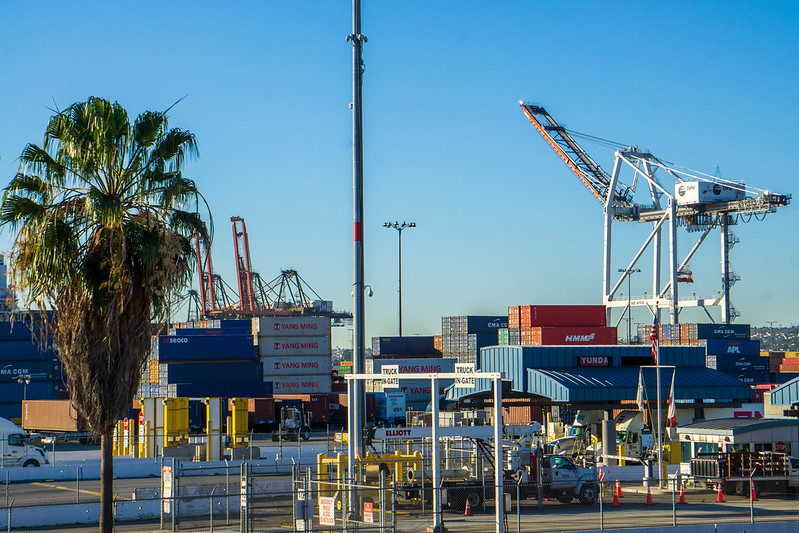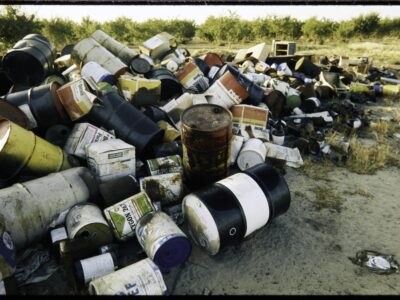How to Get to Zero Emissions at the Ports
A new report by UCLA and UC Berkeley examines policy solutions to accelerate deployment of zero-emission cargo handling equipment at the Ports of Long Beach and Los Angeles.

The Ports of Los Angeles and Long Beach are well on their way toward electrification, but the road to zero emissions is a long one. This new report—A Heavy Lift: Policy Solutions to Accelerate Deployment of Zero-Emission Cargo Handling Equipment at the Ports of Long Beach and Los Angeles and Beyond—surveys the biggest obstacles to speedy electrification and makes some recommendations.
The Ports are the largest in the United States, serving as a hub of economic activity for the L.A. region and the State of California. Goods movement through these Ports also benefits consumers throughout the U.S. However, goods movement through the Ports is a major source of air pollution and greenhouse gas emissions in the L.A. region. The South Coast Air Quality Management District has reported that the Ports are “the single largest fixed source of air pollution in Southern California.” And neighboring communities—predominantly low-income communities of color—bear the brunt of this pollution, suffering from smog and toxic air pollution from port equipment.
Greenhouse gas emissions at the Ports come from three main sources: ships, heavy-duty vehicles, and cargo handling equipment (“CHE”). Cargo handling equipment is the third largest source of emissions accounting for approximately 14 percent of the Ports’ total greenhouse gas emissions. The Ports have replaced some fossil-fuel powered equipment with zero-emission models as they work toward goals set forth in their Clean Air Action Plan, including a goal to transition to 100 percent zero-emission CHE by 2030. However, more work is needed to fully transition the Ports large CHE fleet to zero-emission models. While some consider cargo handling equipment the “low hanging fruit” of port emissions reductions, there remain challenges for the transition to zero emissions. Some of the needed ZE technology is still being developed, and communities and workers have raised concerns around the potential for job loss.
To address these concerns, UCLA School of Law’s Emmett Institute on Climate Change and the Environment and UC Berkeley School of Law’s Center for Law, Energy & the Environment (CLEE) hosted a convening of experts from a variety of industries, including environmental, public health, environmental justice, labor, business, and government sectors. We discussed the challenges and opportunities of decarbonizing cargo handling equipment at the Ports. The discussion informed the Emmett Institute’s newest report, A Heavy Lift: Policy Solutions to Accelerate Deployment of Zero-Emission Cargo Handling Equipment at the Ports of Long Beach and Los Angeles and Beyond. The paper discusses barriers to transitioning to electric CHE models and proposes solutions to overcome these barriers.
The report dives into the following barriers:
- Inadequate grid and charging infrastructure to support zero-emission cargo handling equipment and lack of substantial planning and funding to install necessary and timely infrastructure.
- Evolving zero-emission technology for some types of cargo handling equipment and high upfront costs.
- Fear among communities and workers of job loss and of increased emissions from expanded port activities.
The report then recommends several solutions, including:
- The Ports and utilities, chiefly Southern California Edison and Los Angeles Department of Water and Power, could proactively deploy “no regret” infrastructure, including increasing grid capacity and upgrading distribution networks that will be needed regardless of how zero-emission cargo handling equipment is powered.
- The California Legislature; the Air Resources Board; and/or the South Coast Air Quality Management District, using their existing authority grounded in air pollution control, could create technology-forcing mandates and clear, enforceable implementation deadlines, with penalties for non-compliance, to catalyze the zero-emission cargo handling equipment transition. Where technology is not readily commercially available, regulations could incorporate adequate flexibility and sufficient lead time for entities to meet the mandate.
- State and local government could implement policies to promote job preservation, local job creation, and worker training, such as programs that encourage ports and terminal operators to partner with local training organizations to upskill and reskill the workforce to use the new vehicles and technologies.

The transition to zero-emission cargo handling equipment is underway, and these efforts need to be increased, expanded, and accelerated to meet the Clean Air Action plan’s 2030 goal and bring much needed relief for communities living near the Ports. Working together, the Ports, utilities, businesses, workers, environmental organizations, community members, and local, state, and federal governments can make significant progress toward the transition to zero-emission cargo handling equipment.
If you want to dive into this topic further, join us for a webinar discussion on Thursday, November 16th when we’ll discuss solutions with panelists from Southern California Edison, the Port of Los Angeles, and Earthjustice. (You can RSVP here).
The authors would like to thank the convening participants for generously sharing their time, knowledge, and insights with us and Bank of America for sponsoring the convening, which is part of a series.
This post was co-authored by Beth Kent and Gabi Rosenfeld.







Reader Comments